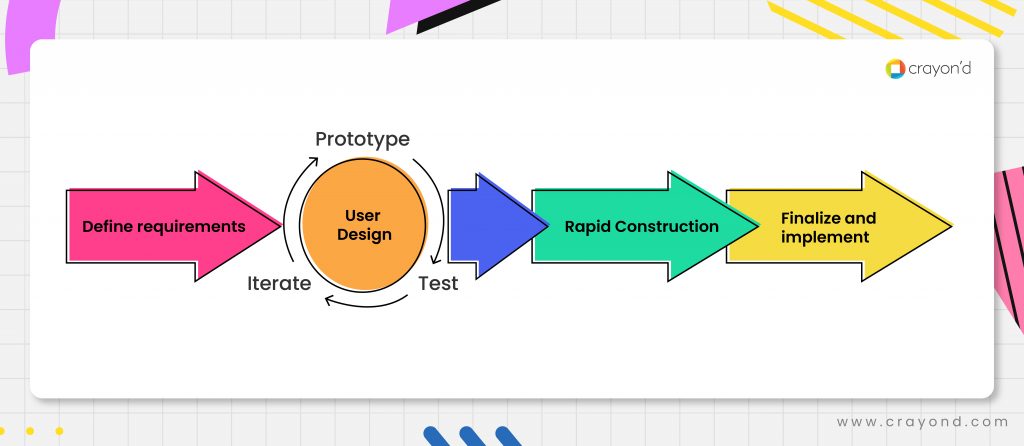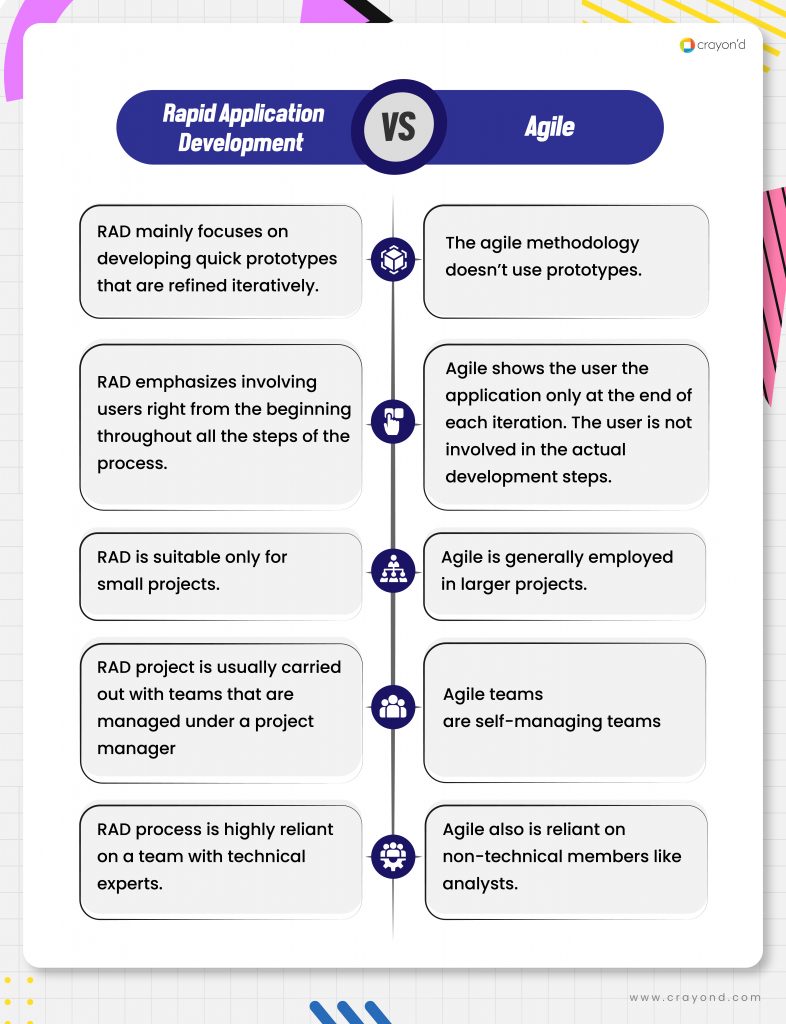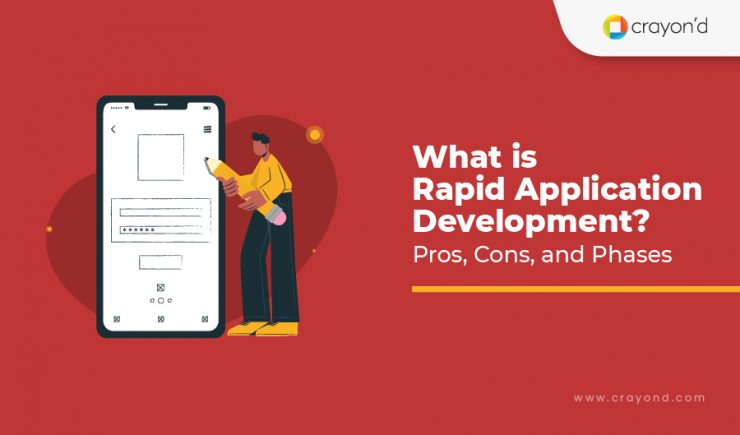The software world is so dynamic.
Innovations keep occurring every second that passes by. Also, the recent pandemic is proof of how the way of life can change in a week/month time.
Everything is happening rapidly. With so many changes coming our way, new problems arise. This brings up the need for new solutions.
The way of living is not slow anymore. You need to come up with timely solutions and deliver them to use on time. If not, its purpose is lost. Also, if you don’t, someone else will. Competition is high now.
Not all problems can be solved instantly. But there are always problems that need immediate attention and solutions. If that’s the case, how can you build software whose development takes years?
The planning phase itself seems so long and dragging. That’s where the Rapid Application Development model can help. In recent years, there have been evolutions happening. Many new software development models came into existence. And RAD is one among them.
Let’s discuss in detail this developmental model elaborating its pros and cons.
What is Rapid Application Development?
Rapid Application Development (RAD) is a software development methodology. It focuses on developing applications through rapid prototyping and quick feedback cycles.
The Rapid Application Development is unlike the waterfall model that emphasizes strict planning. And that makes it difficult to bring in feedback during the development phase. It is hard to change the core features of the application later in the waterfall model. You might need to start everything from scratch.
In the RAD model, the delivery period is shorter and the process insists on flexibility.
Phases of Rapid Application Development

1. Define Requirements
The initial step of any project should be defining its scope. It’s essential to clearly set the goals before kick-starting the development activities. This way you can ensure that no time is wasted on unwanted tasks/activities.
This is the planning phase that involves stakeholders, managers, developers, and clients (software users) as well. It’s not just the scope and goal that gets discussed here. Everyone comes together to speak about the requirements, issues & problems they might face, timelines, and budgets.
In this step, the team listens to everyone’s views, suggestions, and ideas. Ensuring that everyone is on the same page is crucial. Decisions are made by getting approvals from different stakeholders and the entire discussion team.
Collective decision-making can avoid future controversies and miscommunications. And in turn, preventing the changes later in the process that can cost a lot.
2. Prototype
Right after the deciding and defining, the prototyping begins. This is the iterative step in the Rapid Application Development process. Here the developers work hand in hand with the clients.
The main goal is rapid prototyping. It’s important that the developers ensure the ‘rapidness’ factor here.
They design the prototypes of the application based on the requirements drawn from the previous step. Meanwhile, clients test it and give their feedback. Based on their feedback, the prototypes are iterated.
The iterations continue until the application reaches a stage where it is satisfactory. These frequent feedback and improvement cycles make the application user-centric. And making it certain that the user’s expectations are met.
In this model, the direct involvement of the user is what adds strength and eliminates the risk of rapidness.
3. Rapid Construction
Once the design part is done, the team can start with the actual development. This is where the prototypes are converted into working models.
The team builds the application through coding. The integrations are also part of this step. The developed application is continuously tested for bugs and issues. If anything as such is found, the team works on resolving it on the go.
Here, the development process can be done even faster. This is because most of the changes and iterations are discussed and implemented in the previous stage itself.
Another important fact is that the clients (users) are involved in this process as well. They are encouraged to suggest any changes. This can fill the gap between the design and the development processes, ensuring the right transformation.
4. Finalize and Implement
Once the working model is developed, the developers do some final touches on it. And then the application is ready to be moved to the live environment.
But before this, it’s important to refine and recheck if everything is fine. Full-scale testing is carried out to ensure that there are no bugs. After this, the application is finalized and approved.
Now the team can carry out activities to make the application live. User onboarding is also an important part of this phase. Even though a number of iterations and testings are done, there might be few gaps.
The development and testing team must continue to provide support even after the launch.
RAD- Advantages and Disadvantages
Advantages
- 1. Risk Reduction
- The prototypes of the application are reviewed continuously. In every iteration and every phase of this development, testing is done. Also, users are involved from the very beginning of the process. This ensures that the application has lower chances of failure as well as disappointing users.
- 2. Visible Progress
- Rapid Application Development focuses on continuous iterations and sprints. This means the product is developed incrementally and the progress is obvious. And it becomes easier to measure progress. This brings the development process in line with the schedule and the budget.
- 3. Flexible
- Rapid Application Development is very flexible by nature. This development model encourages changes and alterations. Here, changes are actually seen as a way to improve and refine the product. The application is also divided into smaller segments and developed. So it’s easy to modify and incorporate changes in the application at any point in the process.
- 4. Customer Feedback
- The RAD process involves the user right from the beginning. This means there’s almost no chance of them being disappointed with the output. At every step and every progression, users are asked for their views and feedback. This feedback is processed and implemented in the next iteration.
- 5. Better Integration
- In conventional developmental models, integrations occur only during the last stage of development. Integration is the vital part that decides the effective performance of the application. When it comes to Rapid Application Development, integrations occur from the very beginning. This helps to figure out the bugs and complications that arise out of this very early. And these issues are resolved early.
- 6. Quick Delivery
- The main advantage of this process is conveyed in its name itself. RAD enables companies to speed up the development process. The development time is way less compared to other models. This way the end product can reach the markets and its users faster.
Disadvantages
- 1. Efficient Team
- RAD depends on rapid iteration and development. This requires a lot of skill in place. Everyone involved must possess equal and adequate technical expertise. It’s because anyone lagging in the team can slow down others as well. Forming such teams is a difficult task.
- 2. Tough to implement with larger teams
- Rapid AD works fine with teams that are small and closely knit together. It’s because this model requires effective collaboration. Proper communication between team members is very important for such a rapid iterative process.
- Every team member should be able to discuss and collaborate with every other in the team. When the teams become bigger this close association and collaboration become difficult.
- And, RAD is complex to pull off with bigger teams.
- 3. User Involvement
- The crucial part of the RAD process is the user/client. Their involvement is required in almost all the steps of the process. So, the availability of users is vital. If they are not available at the time of important decisions or after, every iteration the process will drag.
- 4. High Commitment to Feedback
- RAD is hugely reliant on user feedback. Regular feedback sessions are a norm of this model.
- Teams need to sit and spend time with users to understand their issues. And this occurs frequently and right after every iteration. Teams require high involvement and commitment to this feedback session. Else the process will not work properly.
- 5. Needs Modularization
- RAD is usually done by separating the application into several modules and developing them. But not all applications/software can be divided into modules. Some need to be developed as a whole. So, RAD cannot be used for those applications that cannot be modularized.
Rapid Application Development vs Agile
The RAD and Agile models are always confused with each other. But that isn’t the case. Here are some major differences between the two.

When to use Rapid Application Development?
While RAD seems to be exciting, it is not suitable for all types of products, projects, and teams. Here are some criteria to look for when you are considering choosing this model.
- Your product can be modularized
- As mentioned earlier, RAD involves dividing the project into smaller portions/modules. Each component should be independent to be developed and tested on its own.
- Learn if your product can be modularized without any technical issues in the background. If the case is favorable, then you can go ahead with the RAD model of development.
- Your team can iterate quickly
- The RAD model involves rapid prototyping and frequent iterations. This is not as easy as it seems. The team must be capable of pulling off these difficult tasks. The constant iterations require energy and expertise, that too with a short span of time.
- And, the feedback cycle brings in different perspectives and regular changes. This demands a quick shift of mindset according to the changing contexts. Your team on the whole must be skilled enough to face every challenge the process brings up.
- Client involvement is assured
- For Rapid Application Development, one important thing you need to ensure is client (user) availability. Your decision relies on this factor. See if your clients are ready for spending time alongside your team providing feedback.
- Make sure they are committed to this involvement. Talk with your clients and understand their willingness to be a part of their process. If they aren’t ready, you need to reconsider choosing this developmental model.
- Budget concerns
- RAD is less expensive compared to other developmental models. However, there are some cases where you might need to hire technical experts for your team. If your team already comprises technical experts, the hiring costs can be eliminated.
- There might also be a need for some automated tools in this process. You must see if your budget can fit all of these requirements.
Tools for Rapid Application Development
RAD mainly comprises two important tasks — prototyping and feedback. That would require the following tools.
- 1. Prototyping Tools
- Figma
- Adobe XD
- Sketch
- Invision studio
- Axure RP9
- 2. User Testing Tools
- Usertesting
- CrazyEgg
- HotJar
- UserZoom
- Optimizely
- 3. Platforms
- There are also platforms that cover the entire Rapid Application Development process.
- Zoho Creator
- KissFlow
- Outsystems
Endnote
Developmental models play a huge impact on how your products shape up. Hence choosing the right developmental model for your product is crucial.
You need to look into the above-mentioned and few other criteria to go ahead with RAD. While Rapid Application Development seems enticing and pursuable, as repeated throughout the blog, it requires expertise. It might be complicated to execute and manage the process well.
If you think RAD would be suitable for your product but feel like you cannot pull it out by yourself, there are digital product agencies to help you. They can take up the entire development process or assist you.
They also provide you with consultation in case you are confused about deciding if RAD is right for you.







Add comment